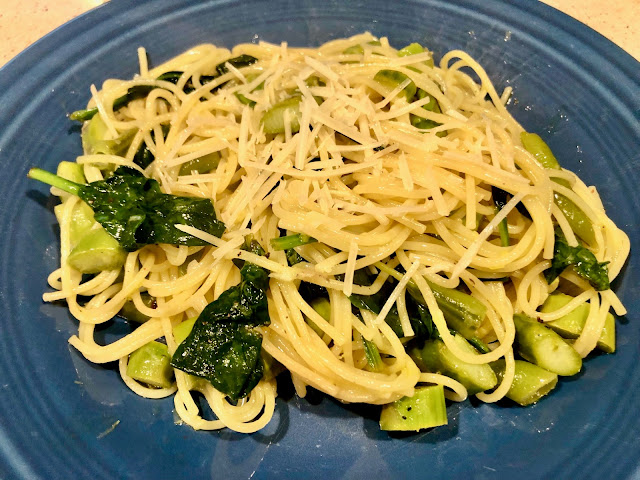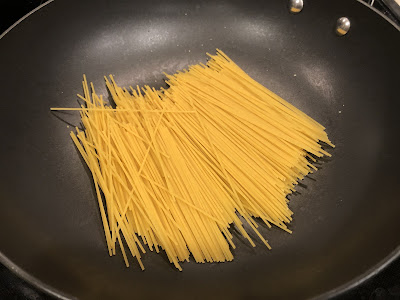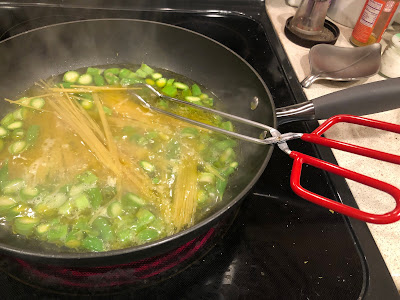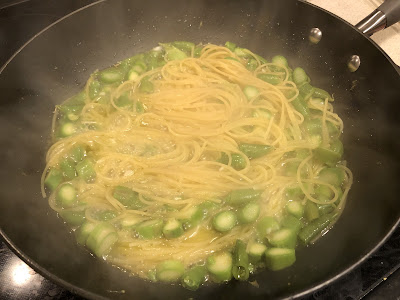
Recipe: Asparagus, fresh peas and mint combine with lemon, spinach
 |
|
Looks like spring, doesn't it? The pasta, veggies and the light, lemony sauce all
cook together in one pan. (Photos: Kathy Morrison)
|
 |
|
The peas, lemon and mint all were grown in my backyard.
|
Happy first day of spring! I sought out a recipe for today that would embody the freshness and the beautiful green of the season. I had asparagus at hand, plus my first harvest of tender peas and lots of fresh mint.
This is one of those trick recipes, where everything cooks in the same pan, and it works quite well. I found it on food52.com , but the original author is Anna Jones from her book “The Modern Cook’s Year.” I’ve adapted the serving amount; it can be easily doubled. Be sure to choose a pasta that cooks in 8 minutes or less; I used thin spaghetti.
The recipe goes quickly, so prep as much as you can before starting to cook. Use a large lidded frying pan, sauté pan or wok that the pasta can fit in flat. (In my case, I broke the thin spaghetti in half before cooking.)
 |
| Start with the dry pasta in the pan. |
One-pan asparagus, lemon and pea pasta
Serves 2 as a main course or 4 as a side
Ingredients :
Large handful clean spinach, baby spinach or sorrel leaves
Zest and juice of 1 lemon, separated
Salt
8 ounces dry pasta, such as thin spaghetti or angel hair
1/2 pound thick or thin asparagus, woody ends snapped off
1/2 cup peas in pod, sliced crosswise in half (if pods are fresh and tender) or 1/2 cup shelled or frozen (defrosted) peas
1 clove garlic, peeled and sliced
2 tablespoons olive oil
1/2 teaspoon flaky sea salt
Handful of fresh mint leaves (chopped or whole leaves, as desired)
Freshly ground black pepper
Grated Parmesan cheese, for serving
Instructions:
In the microwave or a tea kettle, heat 3 cups water to boiling.
 |
| Use tongs to flip the pasta over to make sure it's evenly cooked. |
In a small bowl, "scrunch" the spinach or sorrel between your hands with a pinch of salt and a bit of lemon juice. Set aside. Cut the top 2 inches from the asparagus stalks, set aside, and slice the remainder of the stalks into 1/4-inch rounds.
Place the dry pasta in the frying pan. Add the garlic, lemon zest, oil and 1/2 teaspoon salt to the pot. Pour in 2-1/2 cups of the hot water, put the lid on the pan and bring to a boil. Remove the lid and simmer on high for 4 minutes, turning the pasta in the boiling water with tongs every 30 seconds or so. After 4 minutes, stir in the asparagus rounds and the pea pods or peas, and continue turning the pasta for 4 more minutes.
Stir in the reserved asparagus tips, the spinach or sorrel and the mint leaves, then the lemon juice. Simmer for 2 more minutes.
Most of the water should be evaporated by this point. Check one piece of pasta -- it should be al dente, not crunchy or mushy. If still too crunchy, add some of the remaining boiled water and simmer another minute or two.
 |
|
The pasta is nearly done here. A minute off the heat will help
it absorb the last of the water.
|
Once the pasta is at the al dente stage, remove the pan from the heat and allow the pasta to absorb the remaining water, forming a lemony sauce.
Serve immediately, topped as desired with a grind or two of black pepper and some grated Parmesan.
Comments
0 comments have been posted.Sacramento Digs Gardening to your inbox.
Sites We Like
Garden Checklist for week of July 21
Your garden needs you!
* Keep your vegetable garden watered, mulched and weeded. Water before 8 a.m. to reduce the chance of fungal infection and to conserve moisture.
* Feed vegetable plants bone meal, rock phosphate or other fertilizers high in phosphate to stimulate more blooms and fruiting. (But wait until daily high temperatures drop out of the 100s.)
* Don’t let tomatoes wilt or dry out completely. Give tomatoes a deep watering two to three times a week.
* Harvest vegetables promptly to encourage plants to produce more. Squash especially tends to grow rapidly in hot weather. Keep an eye on zucchini.
* Pinch back chrysanthemums for bushy plants and more flowers in September.
* Remove spent flowers from roses, daylilies and other bloomers as they finish flowering.
* Pinch off blooms from basil so the plant will grow more leaves.
* Cut back lavender after flowering to promote a second bloom.
* It's not too late to add a splash of color. Plant petunias, snapdragons, zinnias and marigolds.
* From seed, plant corn, pumpkins, radishes, winter squash and sunflowers.